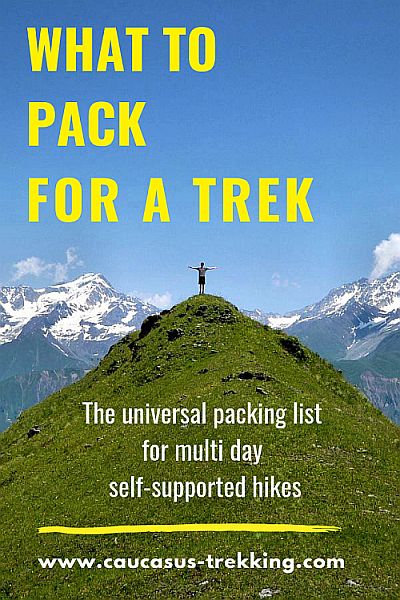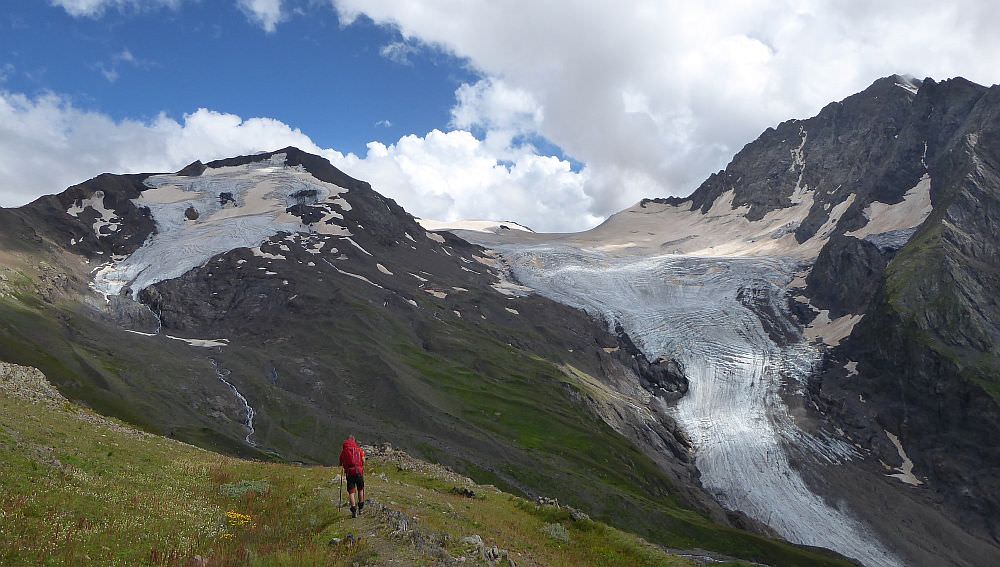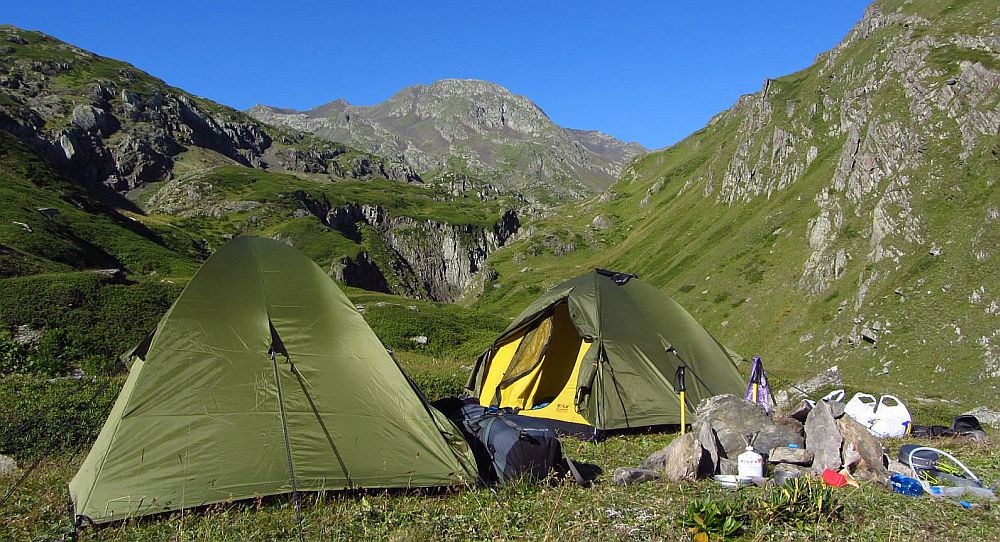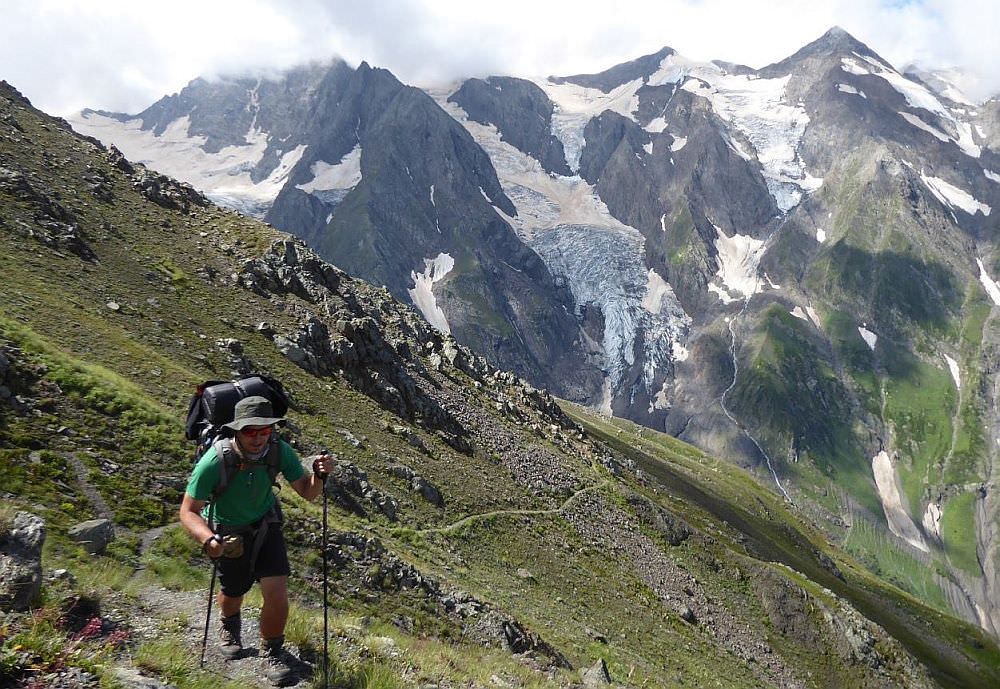My trekking packing list
People sometimes ask me what to pack for their trekking trips. Relevant question indeed, but it's not too convenient to reply everyone in detail. So here is the answer - my packing list for multiday camping trips. In last years, I use it mainly in the Caucasus but it's universal - should work just as well also for hiking in South America or Central Asia.
Just to make it clear - I won't sell this as some "ultimate trekking gear backpacking list", suitable for everybody (because people differ and mountains differ, too) - this is just a list of stuff which works for me. And since it´s already quite long, it contains only not-edible parts - the rest is covered in this post about the trekking food.

I also have to admit that I am no packing guru who follows latest trends and counts every gram. I hate shopping and do it only when I absolutely have to (the older piece breaks down). And since I prefer durable gear, that doesn´t happen that often. So feel free to get inspired but keep in mind that what works for me doesn´t have to suit you.
My packing list is split into the following categories
- 1. Packing & organization
- 2. Footwear
- 3. Clothing
- 4. Camping gear
- 5. Cooking
- 6. Gadgets & Electro
- 7. Hygiene & First Aid
- 8. Common stuff (one piece in a group)
Disclaimer: This article contains affiliate links. Pointing to products. That means that if you click on them and buy something, I will get rich. Finally decided to get registered as an Amazon Associate after being laughed at by my fellow travel blogers for years. Now I am eager to find if it works :)

1. PACKING AND ORGANIZATION
Trekking backpack
When it comes to backpacks, there is no space for a compromise. Because as my grandma used to say, "cheapskate pays twice". And you really don´t want to end up with a torn shoulder strap in the middle of the week-long trek.Backpacks some in various sizes and capacities, each fitting a different purpose. Your pack should be neither too small or too large (who would've thought) - you should be able to fit everything inside without leaving too much extra space (which would tempt you to pack some more stuff). Since my trekking trips often last more than a week, I have a backpack with the capacity of 70 litres. I could save space if I attached some stuff from the outside, but it could get lost during flights (and I don´t want to feel like a walking Christmas tree).
Of course, it can´t be bought anymore. If I had to buy a backpack today, I would certainly go for some lighter model such as Osprey Aether or Deuter Aircontact.
Daypack
Even if you plan a camping trip, you shouldn't forget your daypack. You won't carry a backpack every sigle day and the daypack is indispensable for shorter walks or strolls around the city. Trust me, each year some of my friends regrets not bringing it and has to plead us to pack his snacks or bottle :).Quality here doesn´t matter as much, it should be just light and compressible. I use a 4Monster Hiking backpack, but anything should work .
In case of emergency, you can create a daypack from the compression sack for your sleeping bag. You just need to readjust straps.
Ziploc storage bags
Great for storing things one doesn’t need in the mountains (passport, smartphone), some kinds of food (I mix my own muesli) or various small items you want to keep together. The ones I use are quite small (20 x 13 cm), designed for food, not clothes - bought them at the DM Drogeriemarkt.
Money belt
Useless in mountains but still recommended to have as you will spend at least some time in the cities. I use a MoKo Secure Travel money belt - not sure if there is some difference between individual brands but this one has served me well so far.2. FOOTWEAR
Trekking boots
Together with a backpack, the most important part of your equipment. For trekking with a heavy backpack, I still use high leather boots because of the ankle support but if you do sports, you should be fine even with a lower and lighter boots. As for the specific model, I have Hanwag Alaska. These are the most expensive shoes I ever had, but really comfortable and made from high-quality materials. Even after 7 years, they look pretty good. Last year, I had them resoled and hope they will last a few more years.
Hiking sandals
Hiking sandals are really useful in the evening so your feet can get rest from the heavy boots. We also use them when fording rivers - it´s more comfortable and safe than crossing barefoot.I can sincerely recommend Teva Terra Fi hiking sandals. My first pair lasted seven years and the one I have now looks just as good. These sandals are not only durable but also very comfortable and in spite of the considerable price, they offer a great value for money.
3. CLOTHING
Hiking jacket
From 2020, I've been using Marmot Minimalist Gore-Tex jacket. It looks good, offers great protection from rain and with 425 grams, it's considerably lighter than my old jacket (tho not as much as the name "minimalist" suggests). Of course, performance-speaking, it can't compete with pricier models made by premium brands such as Arc’Teryx, but still, with its 150 EUR price tag, it offers great value for money.
Hiking pants
Hiking pants are nowadays made mostly from some kind of a nylon blend - light and quick-drying. This is a piece of clothing where you can save some money if you are on a low budget as unlike boots and backpack, quality is not so critical.Currently, I have Columbia Silver Ridge convertible pants. They can be shortened to the "above the knees" length and I wear them like this most of the time.
Short hiking pants
I have also another short hiking pants as a backup if the other ones get torn or extremely dirty. Again, these are light, fast-drying and can be pretty cheap.
Polartec jacket
My new favorite piece of clothing is La Sportiva Voyager polartec jacket. What I like the most is that while it's very light (only 350g), it also does a great job at keeping me warm. I use it as a middle layer on the cold days and also as a top layer during chilly mornings and evenings.Unfortunately, it seems that it can't be bought anymore. I did some research and it seems that Berghaus Men's Kyberg Fleece Jacket offers very similar perfomance, it just doesn't look that good. Of course, with greater budget, I would go for Arc'teryx Kyanite Ar jacket, but that's completely different league :)
Underwear - trunks (4x)
I usually pack four pieces. And once in a few days wash them in the morning and let them dry during the day on the top of my backpack.
Merino T-shirt (3x)
As a base layer, I use merino shirts. I won´t elaborate why is merino such a great material, it´s explained in many blogs. Of the three shirts I have, two are for hiking and one is for sleeping.As for the brands, right now I have two Icebreaker 200 Oasis shirts which I use for hiking. I prefer the fabric density of 200g/m2 since the older shirt with density of 150g wasn't as durable as I wanted it to be. So I went for a higher density and couldn't chose better, T-shirts are warm and durable.
The remaining T-shirt is for sleeping and is made by Slovak company Froggywear. It is made of softest available merino wool on the market, with threads only 16.5um thick, which makes it extremely pleasant to the touch.
Ordinary T-shirt
Just an ordinary shirt, used for moving around the cities or as a backup if everything else gets wet.
Long-sleeve shirt
It’s important to have also one long-sleeve shirt, which can be used as a base layer on cold days. At one shop, I stumbled upon a long-sleeve shirt by Extreme Essentials and I am satisfied with it so far. It's comfortable, well-made and cheaper than Icebreaker stuff, mainly because it's not pure merino, but 50:50 merino blend (which makes it more pleasant to waer )
Socks (3x)
My hiking socks are made of merino wool - or, to be more specific, of a blend of merino wool and synthetics (for elasticity and faster drying). They are comfortable, keep my feet warm and dry and don't stink even after several days of trekking. As I rarely hike in winter, I prefer models with light or medium cushioning.Three pairs are enough even for longer treks. Right now, I have two pairs of Icebreaker's Hike & Light Crew socks one pair of Northman's Trekking Light Merino Crew.
Leggings
Great on chilly mornings and evenings. Since I rarely wear them during the whole day, I don't need really top-notch, 100% merino stuff. So I went for much cheaper, but still good Quechua leggings.
Buff
On colder days, I prefer to have my neck covered by an extra layer and for this, buff scarf is an ideal solution - keeps me warm while taking up only a little space. I have several neckwears, but lately use the original merino Buff which I got as a present from my dear wife. I also like it's versatility - while I haven't tried not even a half of advertised 12 ways to wear it, use it from time to time instead of a beanie.
Beanie cap
For colder and windy days, I carry one light merino beanie. Sometimes, when it's really cold, I put it on even during the night.
Hiking hat
Apart from the cap, I have also a hiking hat to protects me during sunny days. The brand or quality doesn't really matter that much as long as it fits, covers the head well and you like what you see in the mirror :).
Rain poncho
During longer rains, even waterproof jacket starts leaking - especially in the shoulders area which is under much higher pressure from backpack straps. Therefore, I carry a rain poncho and put it on when some serious rain starts - it’s great also when you have nowhere to hide and want to wait till the rain ends. Luckily, I don’t have to use it very often but when I do, I am very happy that I have it.
Swimming shorts
Used mostly for sleeping but they occasionally also come handy for trekking on extremely hot days or when I want to dip in the river and there are strangers around.
4. CAMPING GEAR
Backpacking tent
The tent I use these days is MSR Elixir 2. It is the entry-level tent of the otherwise quite expensive MSR brand and offers pretty good value for money - it´s spacious, sturdy, well-designed, easy to build and with its 2,4kg also reasonably heavy (though can´t be compared with ultralight MSR tents such as MSR Hubba Bubba NX-2).Still, I am very satisfied with its quality and performance. The only bummer is that it's not delivered in a compression bag so I had to buy it separately.
Sleeping bag
I prefer sleeping bags with down insulation as, compared to synthetics, it offers much better "warmth to weight" ratio and compressibility. On the other hand, this material loses its properties when it gets wet and takes more time to dry. And, of course, it's more expensive.Right now, I use Rimo 600 sleeping bag made by Czech company Sir Joseph, well-known for their high-quality gear and moderate prices (haven't seen any comparable sleeping bag with 200 EUR price tag, only Warmpeace, another Czech brand, comes close). Also, won't deny it, I like their name :P
Sleeping pad
I use inflatable Trail Scout pad by Therm-a-rest. It’s light, comfortable and can be neatly folded and rolled into the small cylinder which fits very well onto my backpack. On the other hand, as with all inflatable pads, you must pay more attention to where you put it, you don’t want to pierce your 50 EUR pad on a first trip. And I have to laugh when I read about their "life-long warranty". These are good pads (and I am not the most careful owner), but four years are the most I was able to get out of them.
Inflatable sleeping pad fits very well at the top of my backpack
5. COOKING
Cookware
There are several materials to pick from. A few years ago, I moved from stainless steel to hard-anodized aluminum as it’s lighter and distributes heat more evenly. The most expensive sets are made of titanium, but I haven’t tried them yet.Right now, I have several pieces from the Terra Hiker set. I don´t use that small teapot, have only 2 pots - the smaller pan is for the dinners and the larger pot comes handy when we want to make tea, as there is enough for everybody.
Gas canister
Usually you have to buy these in Georgia as you can’t bring gas canisters onto the plane. So you can’t be too picky and buy what’s available. Of course, no-name canisters are cheaper and last shorter, even when the weight is the same.How much gas will you need? As a rule of thumb, the average hiker "consumes" about 30 grams of gas per day - that’s enough to prepare one hot meal and several cups of tea. So plan accordingly.
Camelbak
I really like camelbaks since I can drink anytime you want without the need to stop and put down my backpack. The only con is that I am often not sure how much water is still left inside so I rather carry also a small 0,5 l bottle as a backup.I currently own Deuter Streamer and it's the best camelbak I had so far. What I like the most is the material, it's some sort of smooth rubber which looks clean and sterile even after several years of usage. Another nice feature is the full-width top opening so the bladder can be cleaned much easier than the models with a lid.
Gas stove
MSR Pocket Rocket, small, reliable and handy. Just be careful during cooking and place it properly, because, due to it's compact size, it doesn't take much effort to capsize it.
Tinderbox
Tinderbox is a reliable (and stylish) way to light your gas stove. It can't break or get wet, simply a small and handy gadget. Since I have it, I never used matches for the task. The only downside is that it's good only for lighting of gas so if if you want to make a campfire, you will need those matches, after all.
Spoon
Light my Fire Spork Titanium. I used to carry a plastic version of this classic campping spoon, but always broke one tooth at the "fork side" so I think that this titanium version provides even better value for money :)
Water purification
I will srite more about handling of water during trekking trip in a separate article so for now, I will just say that I use Micropur Forte for water purification. But, of course, always try to boil the water whenever possible as a No. 1 option.
Spice shaker
GSI Ultralight Salt/Pepper Shaker
Also tin mug, set of small steel cups for spirits, dish sponge, box of matches etc etc..
6. GADGETS & ELECTRO
Trekking poles
In my younger years, I refused to use trekking poles, saw using them as a sign of weakness, but nowadays they are an indispensable part of my trekking gear. They make you go faster, especially uphill and greatly offload your knees and ankles. Also, they occupy your arms which 1) makes them stronger 2) they don't feel like a sausages swollen with blood after whole day of uselessly hanging by the body. On the downside, they increase your overall energy expenditure and you may "run out of gas" earlier.Still, I chose to use them. Right now, I own Fizan Compact trekking poles, made by reputable Italian company. Marketed as the lightest trekking poles on the market, one pole weight only 173 grams. So far, I've been using them for two years and must say that in spite of the low weight, they are quite durable. And once they break, I will without any qualms buy them again.
Pocket knife
One can't go wrong with Victorinox pocket knife. I have Victorinox Camper and I used each of its features at least once.
Sunglasses
I use Slovak brand Optimal so that´s not too relevant for you. Pick your favorite brand, just keep in mind that unlike fashionable sunglasses, sport sunglasses should protect the eye from all directions.Camera
Panasonic Lumix DMC-TZ70. Handy superzoom camera that I can carry on my belt - versatile and with a good image quality. Also, it's often referred as one of the best travel compact cameras on the market.
Camera pouch
National Geographic Medium Pouch. TZ70 is slightly larger than my older Canon Powershot camera and didn´t fit into my old pouch. Luckily, I stumbled upon this one. It has a nice, rugged look and more padding than the usual small camera pouch.
Smartphone
- Since I installed Locus maps, I use it for the navigation.Powerbank
Spare camera battery
- as one is not enough for 1 week of trekkingSpare batteries
- AAA batteries for the headlamp.Headlamp
- Black Diamond Spot Headlamp.Charging cables for the camera and smartphone.
Journal with a pen
7. HYGIENE
Toothbrush, toothpaste, interdental brushes
Toilet paper
- reasonable amount, not the whole roll :)Small towel
- usually lose it during the trek, but still keep taking it.Sunscreen lotion
- the higher UV factor, the better. But take only a small tube, not the whole bottle :)Lip balm
- used to get herpes on the 3-4th day of the trek because of the combination of sunstroke and exhaustion. This small guy really helped me with it.Insect repellent
- didn't take it in the last few years since them most problematic insect in the Caucasus are the horseflies and those simply don't care :) Luckily, there are not that many in the Caucasus yet.Pack of tissues
Biodegradable soap
- for washing of hands and also of clothes.Nail clipper
- I thoroughly clip my toenails before the trip but still feel better if I have this one in reserve.First aid kit
How to build your first aid kit? That could be a topic for a separate article, so to make it short, I will just list of hazards and corresponding items in your first aid kit. Also, this is technically also "common stuff" - one in a group is enough
Skin wounds
- antiseptic towels or water syringe (to clean the wound), butterfly bandage (for smaller cuts), sterile gauze pad and bandages (both cotton and elastic) for larger wounds, latex gloves (when things get bloody).Blisters
- leukotape both for prevention and treatmentDiarrhea
- Imodium, Endiex or something similarCold, flu
- Theraflu or something similarVarious pain
(head, teeth) - painkillers8. COMMON STUFF
These items are not needed for everybody - but at least somebody in your hiking group should have them. You won´t need most of them regularly, but once in a while, you can save the day.
Sewing kit
You will truly appreciate this one only after your trousers get ripped around the butt on the first day of your trek.
Rope
Recommended for skilled groups who plan to stray away from well-established hiking trails. Priceless during dangerous river crossings or in steep, semi-climbing terrain.
Guidebook
It's good to have one in a group. Even if you have planned everything in advance, there is a chance that you will at some unexpected place and such cases, guidebook is a great, compact source of the information. The most popular guidebook were published by Bradt and LonelyPlanet.
Map & compass
At least someone should have a clue where you are actually going.
WD40 duct tape
Universal fixing tool. There are so many things in the world that can be fixed with the duct tape!na.amazon

